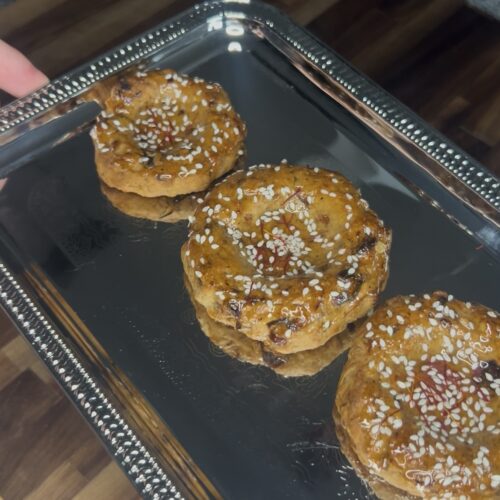If you could step back into the court of Cyrus the Great or walk the colonnades of Darius’s palace at Persepolis, what might they serve as a sweet bite at the end of a meal? It likely wouldn’t be a frosted cake or sugar-laden pastry, but something more elemental, nourishing, and elegant. These honey date cakes, made from crushed walnuts, dates, barley flour, and sesame, offer a taste of that ancient refinement. Naturally sweet and filled with simple, wholesome ingredients, they would have fit perfectly into the Achaemenid world.
Unlike modern desserts, these cakes are packed with energy and free from refined sugar. They offer a healthy treat that’s rooted in real history. Perfect for a ceremonial feast, a Nowruz celebration, or simply as an everyday energy bite for travelers and officials of the Persian Empire.
The Ancient City of Persepolis
Founded by Darius I around 518 BCE, Persepolis was not just the ceremonial capital of the Achaemenid Empire. It was a symbol of the empire’s grandeur, a city built to host guests from across the known world, and a space for rituals, tributes, and festivals. Known in Old Persian as Pārsa, the city was constructed to display the empire’s wealth and unity.
At Persepolis, Persian kings oversaw a realm that stretched from the Indus Valley to the Mediterranean Sea. Every corner of the empire contributed goods and talents, which included food, spices, and cooking methods. The ingredients that went into meals at Persepolis reflect this diversity. It was a place where dried fruits from Mesopotamia, honey from the Iranian plateau, and nuts from the highlands could come together to create dishes both practical and ceremonial.
The Fortification Tablets and the Ingredients Within
Among the most valuable archaeological discoveries related to ancient Persian food culture are the Persepolis Fortification Tablets. These clay documents, dated to around 509 to 494 BCE, are written in Elamite and other scripts and offer insight into the day-to-day workings of the empire. They detail the distribution of food, wine, oil, and livestock to workers, travelers, and court officials.
What makes these tablets fascinating is the list of ingredients they mention. Dates, walnuts, barley, sesame oil, and honey appear regularly, suggesting their importance in both nutrition and ritual. While no recipes are written out, it is easy to imagine these ingredients combined into simple, hearty cakes that could be enjoyed on the go or offered at formal gatherings. This recipe draws directly from that ingredient list to reconstruct a sweet that is authentic in flavor and plausible in function.
Herodotus and the Persian Sweet Tooth
The Greek historian Herodotus, writing in the fifth century BCE, provides valuable insights into the customs of the Persian people. He observed that Persians had a great fondness for dried fruits, sweets, and elaborate meals. Unlike the Greeks, who often ate plain meals, the Persians enjoyed a more indulgent approach to dining.
Herodotus also noted how Persian banquets involved many courses and were often followed by sweet desserts or drinks. This suggests a cultural appreciation for luxurious flavors and the joy of sharing them with others. It is likely that sweet treats like honey and date cakes were served not only for their taste but for their symbolism as offerings of abundance and refinement.
The Recipe: Ancient Persian Honey Date Cakes

Ancient Persian Honey Date Cakes
Ingredients
- 1 cup soft dates pitted
- 1/2 cup crushed walnuts
- 1/2 cup barley flour
- Pinch of salt
- 1 tablespoon olive oil
- Honey for drizzling
- Sesame seeds for garnish
- A small pinch of saffron optional
Instructions
- Preheat your oven to 375°F or 190°C.
- Mash or blend the dates into a thick paste.
- Combine the date paste with crushed walnuts, barley flour, salt, and olive oil in a bowl until a dense dough forms.
- Shape the mixture into small round discs and gently press your thumb into the center of each one.
- Place them on a parchment-lined baking tray and bake for 25 to 30 minutes until they are just golden at the edges.
- Let them cool slightly before drizzling with honey and sprinkling with sesame seeds.
- If using saffron, crush a small pinch and sprinkle over the top just before serving.
Notes
- Softness of Dates Matters: If your dates are a bit dry or firm, soak them in warm water for 5–10 minutes before blending. This makes it easier to form a smooth paste and creates a better-textured cake.
- Barley Flour Substitution: Barley flour gives an authentic earthy flavor, but if unavailable, you can substitute with whole wheat flour. However, the flavor and texture will be slightly different.
- Storage Tip: These cakes keep well for 3–4 days in an airtight container at room temperature. You can also refrigerate them and rewarm slightly before eating to refresh the honey drizzle and texture.
